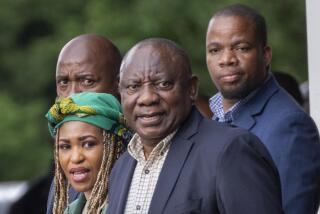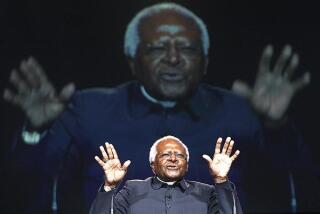ONE MAN’S STRUGGLE
- Share via
From behind bars, Nelson Mandela has dominated the fight for black rights in South Africa. The following are some of the key events in his life. 1944
Mandela joins the African National Congress at age 26, later becoming president of the group’s Youth League. In a short time, the ANC becomes the force behind black protests. When the National Party comes to power in 1948, the ANC begins planning a campaign of civil disobedience to fight the party’s apartheid policy.
June, 1952
Mandela is named leader of the campaign and breaks curfew as the first act of defiance. In December, he is arrested and charged under Suppression of Communism Act. He gets a suspended sentence and is barred from attending meetings or leaving Johannesburg.
December, 1956
A campaign of civil disobedience by the ANC results in Mandela being detained along with 155 others and charged with treason. The trial, which lasts until 1961, ends in acquittal.
March, 1960
Sixty-nine black protesters are killed by police in Sharpeville; a state of emergency is declared and the ANC is outlawed.
January, 1962
Attends Pan-African Freedom Movement Conference in Ethiopia; travels to London to meet with leftists. In August he is charged with incitement and leaving the country illegally; gets five-year jail term.
July, 1963
With Mandela in jail, police raid ANC offices, seizing documents outlining guerrilla campaign. Mandela, seven others are charged with sabotage and conspiracy to overthrow the government.
April-June, 1964
Mandela and seven others are sentenced to life in prison.
May, 1984
Mandela is allowed a visit with his wife--the first since 1962.
January, 1985
President Pieter W. Botha offers to free Mandela if he renounces violence; Mandela refuses until the government takes steps to dismantle apartheid and grants full political rights to blacks.
July, 1988
Mandela turns 70. A rock concert in London is held in his honor. But South Africa bans all local celebrations.
August, 1988
Mandela contracts tuberculosis and is transferred to a hospital. Three months later he is taken to a prison farm in Paarl and placed in a house usually reserved for prison employees.
July, 1989
Mandela meets with outgoing president Botha at the presidential mansion. One week later, Mandela is allowed to make his first officially sanctioned public statement since his conviction. His statement makes clear his position has not changed in 28 years.
December, 1989
President Frederik W. de Klerk meets Mandela for the first time.
February, 1990
De Klerk lifts ANC ban and says Mandela will be released. On Feb. 11, the nation’s best-known black leader becomes a free man at last.
More to Read
Sign up for Essential California
The most important California stories and recommendations in your inbox every morning.
You may occasionally receive promotional content from the Los Angeles Times.










